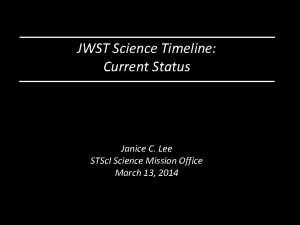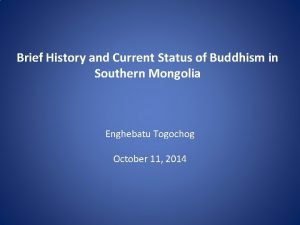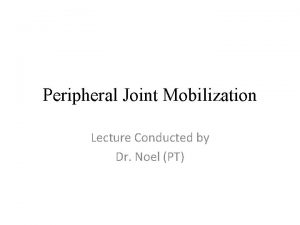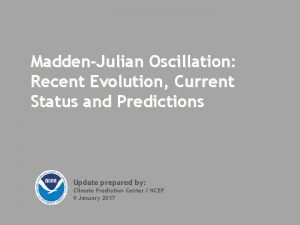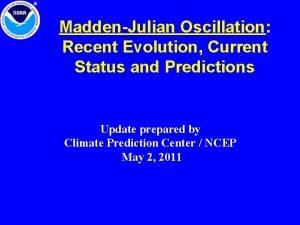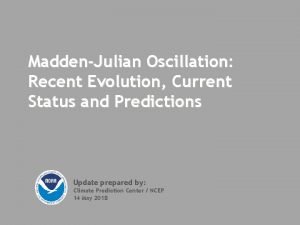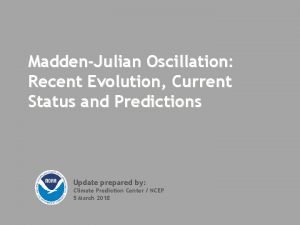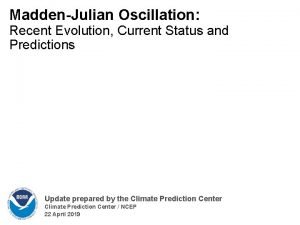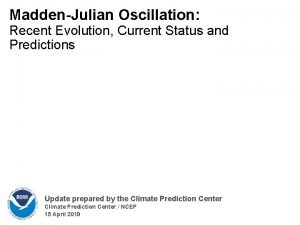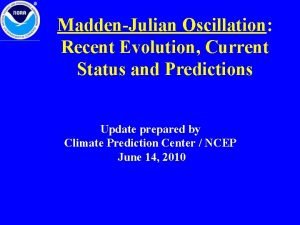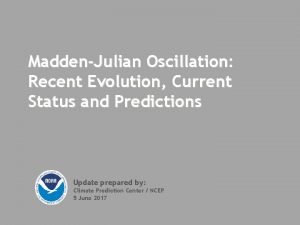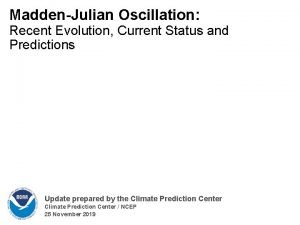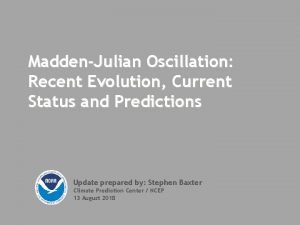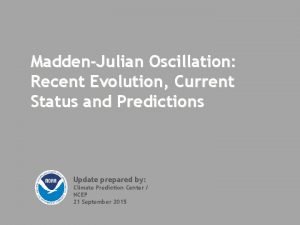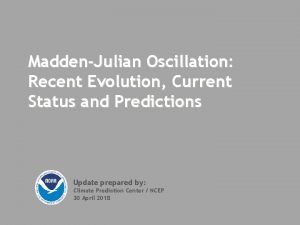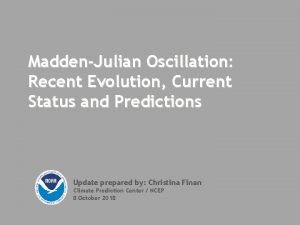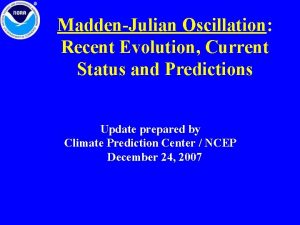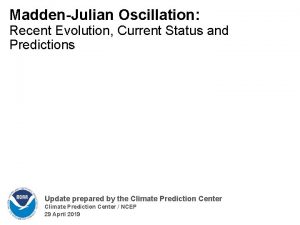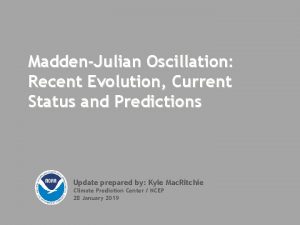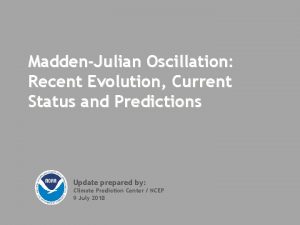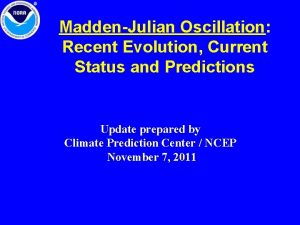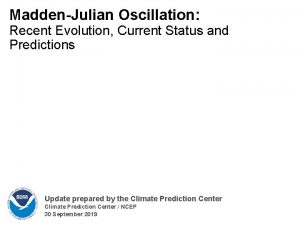MaddenJulian Oscillation Recent Evolution Current Status and Predictions





















- Slides: 21

Madden-Julian Oscillation: Recent Evolution, Current Status and Predictions Update prepared by: Climate Prediction Center / NCEP 25 December 2017

Outline Overview Recent Evolution and Current Conditions MJO Index Information MJO Index Forecasts MJO Composites

Overview The enhanced convective phase of the MJO is currently over the Western Hemisphere, and has recently achieved some disruption of the La Niña base state. Dynamical models show some further weakening of the MJO signal during Week-1 as it continues to destructively interfere with the base state; however, there is good model agreement that the MJO will remain coherent and emerge over the Indian Ocean during Week-2. Based on dynamical and statistical model guidance, the MJO will likely continue to dampen the La Niña atmospheric response during Week-1, and the signal may contribute to enhanced convection across the Indian Ocean during Week-2. Extratropical teleconnections from the MJO to the midlatitude pattern over North America are fairly weak when the enhanced phase is over the Western Hemisphere. If the signal does emerge over the Indian Ocean in Week-2, however, the MJO midlatitude response becomes more robust and would favor a pattern change during the second half of January. Additional potential impacts across the global tropics and a discussion for the U. S. are available at: http: //www. cpc. ncep. noaa. gov/products/precip/CWlink/ghazards/index. php

850 -h. Pa Vector Wind Anomalies (m s-1) Note that shading denotes the zonal wind anomaly Blue shades: Easterly anomalies Red shades: Westerly anomalies Weak easterlies persisted over the Indian Ocean with no evident propagation. Westerly anomalies persisted over the Maritime Continent and east of New Guinea. Easterly anomalies weakened across the Pacific as midlatitude features and the intraseasonal signal destructively interfered with the La Niña base state.

850 -h. Pa Zonal Wind Anomalies (m s-1) Westerly anomalies (orange/red shading) represent anomalous west-to-east flow Easterly anomalies (blue shading) represent anomalous east-to-west flow Low-frequency easterly anomalies (blue box) have largely persisted over the west-central Pacific throughout the last 180 days. During July, a slight eastward shift in the lowfrequency pattern is noted, related to shortlived MJO activity. By August and September, the low-frequency envelope of easterly anomalies re-established from 140 E to just east of the Date Line. During October and early November, a robust MJO event developed, with eastward propagation of westerly and easterly anomalies. This event weakened in early to mid-November. A new MJO event became organized in December, propagating from the Indian Ocean to the Pacific. The signal has been destructively interfering with the La Niña signal over the past two weeks.

OLR Anomalies – Past 30 days Drier-than-normal conditions, positive OLR anomalies (yellow/red shading) Wetter-than-normal conditions, negative OLR anomalies (blue shading) During late November, enhanced convection overspread the eastern Indian Ocean basin and the Maritime Continent as a newly organizing MJO signal constructively interfered with a robust Rossby wave. During early December, tropical cyclone activity spurred by the enhanced convective envelope was evident over the Bay of Bengal and Arabian Sea. The MJO enhanced phase moved out to the western Pacific, but did not substantially disrupt the La Niña atmospheric response over the central Pacific. During mid-December, little eastward propagation of the MJO signal was evident, as Rossby wave activity over the West Pacific influenced the tropical convective pattern. A suppressed convective pattern overspread the Indian Ocean, and remained entrenched over the central Pacific.

Outgoing Longwave Radiation (OLR) Anomalies (2. 5ºS - 17. 5º S) Drier-than-normal conditions, positive OLR anomalies (yellow/red shading) Wetter-than-normal conditions, negative OLR anomalies (blue shading) During mid-July, there was a burst of enhanced convection over the Maritime Continent, due to interactions between a short-lived intraseasonal signal and the lowfrequency state. Multiple modes of variability, including tropical cyclones, contributed to the pattern of anomalous convection during August and September. The low-frequency signal emerged more fully in August. The MJO became active in October, with a stronger projection in the upper-levels than in the equatorial OLR field. After circumnavigating the globe, the signal weakened in early to mid November. Another MJO event developed in late November over the eastern Indian Ocean and Maritime Continent, with some eastward propagation evident.

200 -h. Pa Velocity Potential Anomalies (5ºS - 5ºN) Positive anomalies (brown shading) indicate unfavorable conditions for precipitation Negative anomalies (green shading) indicate favorable conditions for precipitation During July, enhanced convection strengthened over the Maritime Continent. This eastward propagating signal appears more or less intact with a period in line with canonical MJO phase speeds. A signal on the MJO timescale is evident in this field during late August and September. Another MJO event developed near the Maritime Continent during early October, with a large upperlevel footprint near 120 E and robust eastward propagation. The signal circumnavigated the global tropics, reaching the Maritime Continent region about 30 days later, weakening at that time. Since mid-November, renewed MJO activity has been observed, beginning over the eastern Indian Ocean and propagating eastward. This intraseasonal signal has been somewhat weaker, and was briefly disrupted by Rossby wave activity. More recently, the signal has managed to destructively interfere with the base state.

IR Temperatures (K) / 200 -h. Pa Velocity Potential Anomalies THIS SLIDE NOT UPDATED The upper-level VP anomaly field does not exhibit robust MJO-like organization, with the broader divergent signal over the Western Hemisphere broken up due to possible Kelvin wave activity over Africa. The suppressed signal is weak due to destructive interference with the base state over the Maritime Continent. Positive anomalies (brown contours) indicate unfavorable conditions for precipitation Negative anomalies (green contours) indicate favorable conditions for precipitation

200 -h. Pa Vector Wind Anomalies (m s-1) Note that shading denotes the zonal wind anomaly Blue shades: Easterly anomalies Red shades: Westerly anomalies Upper-level easterlies overspread the east-central Pacific as both extratropical wave breaking features and the tropical intraseasonal signal interfered with the La Niña base state. D C

200 -h. Pa Zonal Wind Anomalies (m s-1) Westerly anomalies (orange/red shading) represent anomalous west-to-east flow Easterly anomalies (blue shading) represent anomalous east-to-west flow Starting in July, the anomaly patterns propagated eastward associated with weak MJO activity and atmospheric Kelvin waves. During September, fast-moving eastward propagation of anomalies continued, consistent with additional atmospheric Kelvin Waves. A slower signal was evident over the eastern Maritime Continent and west Pacific. Low-frequency westerly anomalies have remained in place east of 140 E since October, with the exception of a brief period of easterlies in late October. There is also some recent evidence of easterlies over the far Eastern Hemisphere over the last week or so that appear to have extratropical sourcing. More recently, easterly anomalies have developed over the east-central Pacific.

Weekly Heat Content Evolution in the Equatorial Pacific Oceanic Kelvin waves have alternating warm and cold phases. The warm phase is indicated by dashed lines. Downwelling and warming occur in the leading portion of a Kelvin wave, and upwelling and cooling occur in the trailing portion. Negative upper-ocean heat content anomalies persisted over the eastern Pacific.

MJO Index -- Information The MJO index illustrated on the next several slides is the CPC version of the Wheeler and Hendon index (2004, hereafter WH 2004). Wheeler M. and H. Hendon, 2004: An All-Season Real-Time Multivariate MJO Index: Development of an Index for Monitoring and Prediction, Monthly Weather Review, 132, 1917 -1932. The methodology is very similar to that described in WH 2004 but does not include the linear removal of ENSO variability associated with a sea surface temperature index. The methodology is consistent with that outlined by the U. S. CLIVAR MJO Working Group. Gottschalck et al. 2010: A Framework for Assessing Operational Madden-Julian Oscillation Forecasts: A CLIVAR MJO Working Group Project, Bull. Amer. Met. Soc. , 91, 1247 -1258. The index is based on a combined Empirical Orthogonal Function (EOF) analysis using fields of near-equatorially-averaged 850 -h. Pa and 200 -h. Pa zonal wind and outgoing longwave radiation (OLR).

MJO Index – Recent Evolution The axes (RMM 1 and RMM 2) represent daily values of the principal components from the two leading modes The triangular areas indicate the location of the enhanced phase of the MJO Counter-clockwise motion is indicative of eastward propagation. Large dot most recent observation. Distance from the origin is proportional to MJO strength Line colors distinguish different months The RMM-index exhibited robust eastward propagation over the Pacific during the past week, with the index weakening slightly over the past couple of days as the MJO enhanced phase destructively interfered with the La Niña base state.

MJO Index – Historical Daily Time Series Time series of daily MJO index amplitude for the last few years. Plot puts current MJO activity in recent historical context.

GFS Ensemble (GEFS) MJO Forecast RMM 1 and RMM 2 values for the most recent 40 days and forecasts from the GFS ensemble system (GEFS) for the next 15 days light gray shading: 90% of forecasts dark gray shading: 50% of forecasts Given the destructive interference from the base state, which would favor enhanced convection over the Maritime Continent, the GEFS forecast shows a robust evolution of the MJO, with re-emergence over the Indian Ocean during Week-2. The ensemble members are also clustered fairly close together on this solution. Yellow Lines – 20 Individual Members Green Line – Ensemble Mean

Ensemble GFS (GEFS) MJO Forecast Spatial map of OLR anomalies for the next 15 days The GEFS plot of MJO related OLR anomalies is unavailable at this time. OLR anomalies based on the GEFS RMM-index forecast are relatively weak during Week-1 as the MJO competes with the base state. During Week-2, the MJO anomaly pattern becomes much stronger. Figures below show MJO associated OLR anomalies only (reconstructed from RMM 1 and RMM 2) and do not include contributions from other modes (i. e. , ENSO, monsoons, etc. ) Time-longitude section of (7. 5°S-7. 5°N) OLR anomalies - last 180 days and for the next 15 days The GEFS plot of MJO related OLR anomalies is unavailable at this time.

Constructed Analog (CA) MJO Forecast Figures below show MJO associated OLR anomalies only (reconstructed from RMM 1 and RMM 2) and do not include contributions from other modes (i. e. , ENSO, monsoons, etc. ) Spatial map of OLR anomalies for the next 15 days Time-longitude section of (7. 5°S-7. 5°N) OLR anomalies - last 180 days and for the next 15 days The GEFS plot of MJO related OLR anomalies is unavailable at this time. The constructed analog depicts a robust MJO event emerging over the Indian Ocean during Week-2. The propagation speed depicted by the statistical tool is slightly slower than the GEFS solution.

MJO Composites – Global Tropics 850 -h. Pa Velocity Potential and Wind Anomalies (Nov - Mar) Precipitation Anomalies (Nov - Mar)

U. S. MJO Composites – Temperature Left hand side plots show temperature anomalies by MJO phase for MJO events that have occurred over the three month period in the historical record. Blue (orange) shades show negative (positive) anomalies respectively. Right hand side plots show a measure of significance for the left hand side anomalies. Purple shades indicate areas in which the anomalies are significant at the 95% or better confidence level. Zhou et al. (2011): A composite study of the MJO influence on the surface air temperature and precipitation over the Continental United States, Climate Dynamics, 1 -13, doi: 10. 1007/s 00382 -011 -1001 -9 http: //www. cpc. ncep. noaa. gov/products/precip/CWlink/MJO/mjo. shtml

U. S. MJO Composites – Precipitation Left hand side plots show precipitation anomalies by MJO phase for MJO events that have occurred over the three month period in the historical record. Brown (green) shades show negative (positive) anomalies respectively. Right hand side plots show a measure of significance for the left hand side anomalies. Purple shades indicate areas in which the anomalies are significant at the 95% or better confidence level. Zhou et al. (2011): A composite study of the MJO influence on the surface air temperature and precipitation over the Continental United States, Climate Dynamics, 1 -13, doi: 10. 1007/s 00382 -011 -1001 -9 http: //www. cpc. ncep. noaa. gov/products/precip/CWlink/MJO/mjo. shtml
 Line currents
Line currents Power formula three phase
Power formula three phase Energy band diagram of pnp transistor
Energy band diagram of pnp transistor Ac systems lesson 4
Ac systems lesson 4 Drift current and diffusion current
Drift current and diffusion current Intrinsic semiconductor
Intrinsic semiconductor Line current and phase current
Line current and phase current Slideplayer
Slideplayer Diffusion current formula
Diffusion current formula 22/60 powder means
22/60 powder means In this figure
In this figure All of the heat produced by sma weld stays in the weld.
All of the heat produced by sma weld stays in the weld. Touch current vs leakage current
Touch current vs leakage current Mesh current method with current source
Mesh current method with current source Current program status register
Current program status register Scientist project
Scientist project Current status of buddhism
Current status of buddhism Periodic motion pendulum
Periodic motion pendulum Non-thrust oscillation techniques
Non-thrust oscillation techniques Mobilization grades
Mobilization grades What is the amplitude of the oscillation
What is the amplitude of the oscillation Graded oscillation technique
Graded oscillation technique















